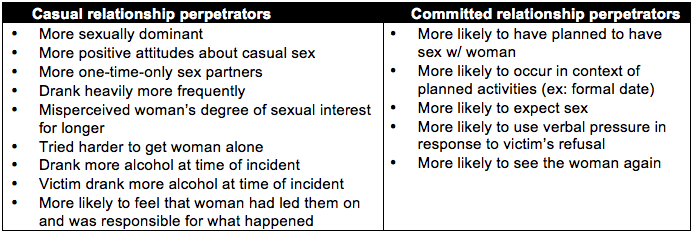How relationship status affects sexual violence perpetration

As sexual violence prevention practitioners, we know that over 80% of sexual assaults are perpetrated by someone the victim knows. But we know less about how perpetration is different depending on the perpetrator’s relationship to the victim, and this information could be really informative to our primary prevention efforts.
A new study looked at how perpetrators’ attitudes, behaviors, and perpetration tactics varied based on whether they were in a casual or a committed relationship with the victim, and based on whether they had “sexual precedence,” or previous consensual penetrative sex with the victim. I think these are interesting questions, especially since social expectations for “hooking up,” or casual relationships, can be really different from those for committed relationships. To me, the main takeaway of the study was that male sexual entitlement is a factor in sexual assault in all types of dating relationships. Another interesting finding was that perpetrators were more likely to use alcohol and other drugs in casual relationships than in committed ones.
The study surveyed over 200 single men in Detroit, aged 18-35, who had committed at least one act of sexual aggression against a woman they knew. The study was limited to men perpetrating against women, excluding all female perpetrators and probably some men who perpetrated against other men. But the information it did provide can still be useful.
The study identified characteristics of perpetrators in both categories:
 Regardless of the type of relationship, perpetrators who did have sexual precedence with the victim were more sexually dominant than those who did not. They also more often believed the woman was obligated to have sex with them, less often felt responsible for the incident, and committed more acts of sexual aggression. This makes pretty good sense to me, since it’s still an all-too-common belief that once a woman has consented to sex once, she should always consent.
Regardless of the type of relationship, perpetrators who did have sexual precedence with the victim were more sexually dominant than those who did not. They also more often believed the woman was obligated to have sex with them, less often felt responsible for the incident, and committed more acts of sexual aggression. This makes pretty good sense to me, since it’s still an all-too-common belief that once a woman has consented to sex once, she should always consent.
The study also had very interesting findings about the tactics that different kinds of perpetrators used. All kinds of perpetrators often used signs of displeasure (sulking, making woman feel guilty, getting angry, threatening to end relationship, etc.). But there were differences in the tactic or mix of tactics that each group used most:
 Only 2% of all perpetrators threatened or used physical force as a tactic, and all of those perpetrators had sexual precedence with the victim.
Only 2% of all perpetrators threatened or used physical force as a tactic, and all of those perpetrators had sexual precedence with the victim.
The authors offered interesting explanations for some of these findings. In casual relationships without sexual precedence, perpetrators may be less likely to believe they can talk a reluctant woman into sexual activity, and thus may be more likely to select a victim who can’t resist due to intoxication or incapacitation. The authors also suggest that in committed relationships without sexual precedence, the tactics might depend on factors like the length of the relationship or the perpetrator’s willingness to manipulate the victim. I think it’s important to highlight the balance between advocating for your own sexual needs and respecting your partner’s boundaries. To me, the difference between healthy discussion and compromise around sexual activity versus coercion is both partners constantly, deeply respecting each other and their wishes. Prevention messaging for all audiences should focus on healthy sexual relationships built on this kind of respect.
The authors also explained that showing displeasure in response to a woman’s refusal is an expression of male sexual entitlement. Because this tactic is common in all of the categories, the study suggests that male sexual entitlement is a problem for both committed and casual relationships, with or without sexual precedence. Male sexual entitlement is a pervasive, rape-supportive component of male gender socialization, and countering this norm should be a part of primary prevention.
The study also suggests that prevention messages should consider the context of casual versus committed relationships. Because perpetrators in casual relationships are more likely use drugs or alcohol as a perpetration tactic and to drink heavily themselves, messaging regarding alcohol might be better targeted toward people who tend to have casual relationships.
Full citation: Wegner, R., Pierce, J., & Abbey, A. (2014). Relationship type and sexual precedence: Their associations with characteristics of sexual assault perpetrators and incidents. Violence Against Women. Advance online publication.
Link: http://vaw.sagepub.com/content/early/2014/10/01/1077801214552856.abstract
Full abstract:
“Although most sexual assaults are committed by men who know their victims, few researchers have considered how characteristics of perpetrators and incidents differ depending on the victim–perpetrator relationship. This study addresses this gap with a community sample of 204 men who reported committing a sexually aggressive act in an audio computer-assisted self-interview. 2 (Relationship Type: Committed vs. Casual) × 2 (Sexual Precedence: Yes vs. No) ANOVAs revealed significant main effects of relationship type and sexual precedence associated with individual difference and incident characteristics. These findings demonstrate the importance of developing theories and prevention programs tailored for different relationship contexts.”
